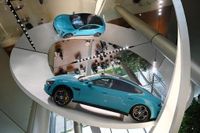In the heart of Beijing, an unlikely tourist hotspot has emerged—not a centuries-old temple or a bustling market, but a state-of-the-art electric vehicle (EV) factory. This sleek complex, built by Xiaomi, China’s largest smartphone maker, is drawing crowds so large that would-be visitors must book their spot a month in advance. Sometimes, at the busiest moments, entry is determined by lottery, leaving many hopefuls crossing their fingers for the chance to witness a technological spectacle in action.
The phenomenon, reported by Financial Times and echoed by AFP, is nothing short of remarkable. Xiaomi, once dismissed as a mere assembler of gadgets and nicknamed a “Lego” manufacturer by skeptics, is now positioning itself as a genuine high-tech powerhouse. Its EV factory, which produces the much-anticipated SU7 Max electric car, is at the center of this reinvention. Every day, throngs of Xiaomi’s most devoted fans—known as “mi fen”—flock to the plant, eager to see the production line churn out a brand new car every 76 seconds. That’s not a typo: one car, just over a minute, again and again, from sunrise to sunset.
What’s fueling this surge of interest? For starters, Xiaomi’s foray into electric vehicles marks a bold pivot from its roots in smartphones and consumer electronics. The company is not just dipping its toes into the EV market; it’s diving headfirst, with ambitions to rival the likes of Tesla and Apple. The factory itself has become a symbol of this ambition—a gleaming testament to what happens when cutting-edge automation meets the fervor of a devoted fan base.
Tour guides at the factory don’t shy away from comparisons to Tesla. In fact, they lean into them, proudly highlighting how Xiaomi is seeking to emulate the American giant’s famously automated production lines. “Our manufacturing processes are on par with Tesla’s,” one guide explained to visitors, according to Financial Times. The company has invested heavily in automation and robotics, aiming to build critical EV components in-house—just as Tesla does in its Gigafactories around the world.
The similarities don’t end there. Like Tesla, Xiaomi is betting that vertical integration—the practice of designing and manufacturing as many components as possible under one roof—will give it a crucial edge in the fiercely competitive EV market. By controlling every aspect of the manufacturing process, Xiaomi hopes to deliver vehicles that are not only technologically advanced but also affordable and reliable. The factory tour, in many ways, is a living advertisement for this philosophy: visitors can watch as robotic arms assemble chassis, install batteries, and even perform quality control checks, all with astonishing speed and precision.
But it’s not just the technology that’s drawing crowds. There’s a palpable sense of community among the visitors, many of whom identify as “mi fen”—a term that translates to “rice fans” and is used to describe Xiaomi’s most loyal supporters. For these fans, the factory is more than just a place where cars are made; it’s a pilgrimage site, a chance to witness the future of Chinese manufacturing up close. Some have traveled from other provinces, braving long journeys and complicated booking procedures just to spend a few hours inside the plant.
“It’s like watching history in the making,” said one visitor, echoing the sentiments of many others. The tours are meticulously organized, blending technical explanations with moments of spectacle. There are demonstrations of the factory’s advanced automation systems, opportunities to see finished SU7 Max vehicles up close, and even interactive exhibits that let visitors try their hand at assembling virtual EV components. The experience is part education, part entertainment—and, for Xiaomi, a powerful tool for building brand loyalty.
The factory’s popularity has also sparked comparisons to other industrial tourism destinations around the world. Tesla’s Gigafactories in the United States and Europe have long attracted enthusiasts and industry watchers, but Xiaomi’s approach is uniquely Chinese, blending high-tech showmanship with a sense of communal pride. The company’s willingness to open its doors to the public—albeit with strict booking requirements—signals a confidence in its manufacturing prowess and a desire to be seen as an innovator on the global stage.
Of course, the stakes are high. The global EV market is crowded and fiercely competitive, with established players like Tesla, BYD, and traditional automakers all vying for dominance. For Xiaomi, success in this arena would mark a dramatic transformation from its origins as a smartphone maker. The company’s leadership has made it clear that they see EVs as the next frontier, and they’re investing accordingly.
According to AFP, Xiaomi’s strategy is to leverage its expertise in consumer electronics—particularly its mastery of supply chains and cost management—to disrupt the EV market in the same way it disrupted smartphones. The SU7 Max, the flagship model produced at the Beijing factory, is designed to showcase the best of what Xiaomi has to offer: advanced connectivity, smart features, and a price point that undercuts many competitors. Early reviews have praised the car’s design and technology, though the real test will come as Xiaomi ramps up production and begins exporting vehicles beyond China’s borders.
For now, the factory remains a symbol of what’s possible when ambition meets innovation. The daily crowds, the buzz on social media, and the growing waiting list for tours all point to a company on the rise. As one tour guide put it, “We want people to see that Xiaomi is more than just a phone maker. We are building the future—one car at a time.”
It’s a bold claim, but as the factory continues to churn out a car every 76 seconds, it’s one that’s hard to dismiss. For Beijing’s newest tourist attraction, the road ahead looks bright—and, if Xiaomi has its way, electric.




